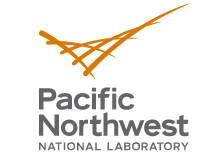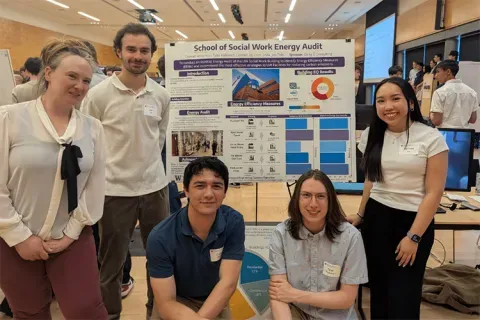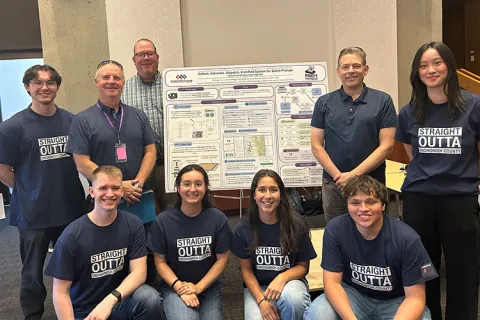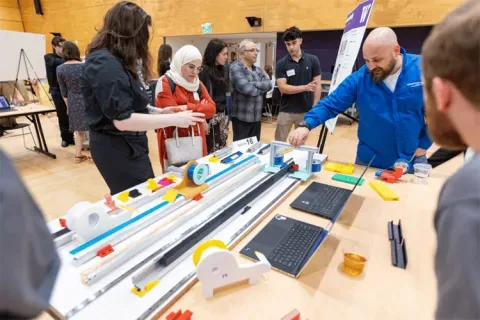Industry-Sponsored Student Capstone Projects
2021/2022
In the 2021/22 academic year the industry capstone program was supported by 62 sponsors and 95 real-world projects. Over four hundred students from across the College of Engineering participated. Scroll down to learn more about each project.
PACCAR
Side Extender "Flapping" Issue
Fairings and extenders are commonly used on big rigs to reduce drag and improve performance but can be affected by the wind in ways that lead to undesirable levels of flapping. The student team worked to explore the wind effect on cab/sleeper extenders using a Fluid Structure Interaction (FSI) analysis method to form predictions. This project started two years ago with a student team performing a combination of CFD and FEA on a side extender CAD model. This year’s student team validated the previous team's results in the wind tunnel, picked up where the previous team left off, and worked to create an analysis method that the PACCAR Technical Center can use for future predictions.

PACCAR
Tank Sloshing Simulation
The Structural Analysis group at PACCAR Technical Center has been analyzing fluid filled tanks for many years using concentrated mass located at the tank's CG. This is a gross simplification that leads to inaccurate results, but better methods are not sufficiently developed. This student team worked to develop such a model and predict the structural effects of fluid sloshing around in the tank on mounting brackets, on the tank itself, and even on sensors and pickup tubes inside the tank. The team used a computer simulation to develop a model then used results and predictions from that simulation to build a physical model for validation.

Pacific Northwest National Laboratory (PNNL)
Few-Shot Machine Learning for Electron Microscopy Data Analysis
This student team studied the use of few-shot machine learning (ML) methods for segmentation and classification of features in electron microscopy data sets of materials for energy conversion, storage, and next-generation quantum computing. Few-shot ML has been proposed as one alternative approach to learn novel visual concepts based on little to no prior information about data. Few-shot has seen minimal usage within the materials science community, primarily in the analysis of electron backscatter diffraction (EBSD) patterns, but it has great potential to inform triaging and classification tasks in novel scenarios. Pacific Northwest National Laboratory (PNNL) has recently developed a few-shot code for segmentation of electron microscope images and an associated graphical user interface (GUI). Because of the novelty of this technique, there are currently many unanswered questions about its suitability to examine microstructural features. The student team evaluated the performance of few-shot ML as it relates to microstructural analysis of electron microscopy data, evaluated classification performance relative to current codes and the potential implementation of new architectures or statistical analyses, and explored the suitability of few-shot ML methods for this novel domain problem.

Pacific Northwest National Laboratory (PNNL)
Thermal Gradient Energy Harvesting Device for Powering Unmanned Underwater Vehicles
There is a demand for self-powered unmanned underwater vehicles (UUVs) suitable for long-term deployments for ocean environmental monitoring. Thermal gradient energy-generation technologies for powering UUVs or autonomous sensing systems in the ocean are mainly in the research development phase, and further research related to small-scale ocean thermal gradient energy systems is needed. Phase change materials can be used to power a buoyancy engine and generate electricity, but currently have low efficiencies. This student team developed conceptual solutions for increasing the efficiency through improved mechanical architecture and design, and a benchtop prototype design for demonstrating the working principle and performance of a novel PCM-based thermal energy harvesting system that has the potential to improve energy harvesting efficiency over traditional PCM-based designs.

Pacific Northwest National Laboratory (PNNL)
Through-Ice Energy Harvester Deployment Mechanism
Generating electrical power from currents and waves may enable ocean sensing in energy-constrained environments like high latitudes where other renewable sources like solar may not be practical or viable. One area of interest is powering sensors fixed to sea ice, which is critical for understanding the warming arctic. To power such sensors, devices are being investigated that can harvest the energy from the relative motion between floating sea ice and water, such as small turbines or vortex-induced-vibration elements. A key design challenge for these devices is how the harvesting system accesses the ice/water interface underneath the sea ice and secures itself there, particularly on ice too hazardous to safely support access by personnel. The student team worked to develop conceptual solutions and a prototype design of an automated deployment and securement mechanism for a current energy harvester below the ice that can position and secure an energy harvesting system under floating sea ice from a starting position at the ice surface and facilitate electrical connectivity from the harvester to sensors at the ice surface. The system is equipped with enough energy to complete its task and self-deploy with no additional human intervention and is expected to survive through a full season of ice breakup and melting.

Philips
Mechanical CPR for Broader Dissemination
Good quality CPR is a significant factor in survival from Sudden Cardiac Arrest (SCA). There are more than 356,000 out-of-hospital cardiac arrests annually in the U.S., nearly 90% of them fatal. Delivery of high quality chest compressions is difficult, often inconsistent, subject to responder fatigue and practically challenging. Mechanical CPR (mCPR) can improve CPR quality and also increase the safety for responders who are often trying to do manual CPR in a moving ambulance without seat belts. Current mechanical devices on the market are big, bulky, and very expensive. There is a need for a mechanical CPR device that performs equivalent to those currently on the market (both downward and upward pressure) but at 1/2 to 1/3 the cost/price. The student team created a mechanical CPR device that is easy to apply, size inclusive, provides added security, is compatible with AED and IV, is rapidly removable, and is optimized for weight.
Photonic Sentry
Mosquito Flight Monitoring: Benchmarking Performance of a Stereo Vision System
Photonic Sentry has developed the Photonic Fence Monitoring Device (PFMD) for entomologists to study the 3D flight behavior of insects with great accuracy. The student team benchmarked the positional accuracy of the system. The results of this work help Photonic Sentry develop updates to the software and data processing systems to improve data quality, as well as inform future clients of the limitations of the device.
Plugable Technologies
Plugable Multiport USB-C Charger
USB-C is widely used these days for fast charging and other capabilities. Taking advantage of this, the team designed a 5V 4A power supply that charges up to 5 USB-C devices overnight, using Plugable's patented "priority charging" algorithm. This algorithm supports charging the highest priority port up to 15W, with power dynamically shifting to the lower priority ports as each device completes charging in succession. The team created a prototype PCD board with fully analog components that follow the patented algorithms and the USB-C Power Delivery protocol.
RealNetworks
Quantifying Bias In AI: Detecting Bias Along the Machine-Learning Pipeline
The growth of face recognition (FR) technology has been accompanied by consistent assertions that demographic dependencies could lead to accuracy variations and potential bias. For over a decade, the tech industry has anticipated the integration of computer-vision into the human / machine interface to enhance automation. As it turned out, the early traction for FR comes from security and surveillance applications, rightfully prompting dystopian fears. While engineers have benefited from the availability of AI and machine learning tools, allowing them to train their models to ever higher accuracy, the fairness and ethics of their algorithms have often been an afterthought. This project aims to develop a tool set to measure and reduce bias in AI training sets, test sets, and resulting models. Further, its goals include practical Tech Policy recommendations for the industry regarding bias of AI models.
RealNetworks
Real-Time SDR to HDR Up Conversion with Automatic Dynamic Mid-Level Tone
Display technology has advanced over the past decade, providing consumers with smart TVs of higher resolution, frame rate, brightness and significantly more vibrant colors (HDR). However, movies are still captured, encoded and rendered in a format that doesn't take advantage of colors available (SDR). The student team worked to solve the problem of SDR to HDR conversion using a mix of color theory and AI rather than brute force machine learning only.
RealNetworks
Speed Matters: Video Facial Recognition
Current Facial Recognition (FR) evaluations performed by the National Institute of Standards and Technology (NIST) use still photos, not from video. However, successive frames of a video stream can provide a single context of and individual's presence such that consecutive recognitions of the same individual could be made with increasing confidence. The student team worked to redefine FR accuracy for real-time video and evaluate the hypothesis that accuracy compounds with successive frames of a live video feed or develop an alternate formula.
Sagetech Avionics
Remote ID Solution for Unmanned Aircraft Systems
Sagetech Avionics designs micro transponders and collision avoidance systems for use primarily in Unmanned Aircraft Systems (UAS) but that are also relevant to crewed aircraft. UAS are now required to be equipped with a remote ID solution, which is essentially a Bluetooth 4/5 or Wi-Fi transceiver that broadcasts data and can be displayed on a smartphone. The device needs to reach a range of 2km. There is a specified data format that is detailed to transmit the UAS ID, type, timestamp, operational status, position, altitude, velocity, heading, etc. This student team worked to build prototype hardware that can be used on multiple UAS to be tracked on a common display application on a smartphone/tablet. They completed a drawing package, executed hardware, software, and application software test plans, documented results, and performed applicable environmental tests.
Sironix
Efficient Purification of Green Surfactants
Sironix Renewables is a seed level start-up exploring manufacturing routes to their Eosix line of plant-based surfactants. As a company they are exploring multiple surfactant formulations and multiple synthetic routes to economically and in an environmentally responsible manner produce their materials. In one iteration, a series of reactions is carried out to produce the surfactant precursors, followed by a series of separations and purifications, recycling of solvents and unused reactants, and treatment of waste streams. The advantages of this specific process is a facile synthesis of the desired materials; drawbacks include the use of multiple solvents and the production of several waste streams that must be mitigated or disposed of. A thorough design and analysis of the downstream separations required for an industrial scale production based on this technology has not been done. The design and implementation of an efficient chemical separation system is essential to the economic success of this specific surfactant synthesis process. The student team worked to evaluate separation methods using literature review, analysis of Sironix’s data, and process simulations to identify one or more suitable purification methods for each of the separation challenges in this process, optimize the separation train(s) using a state of the art process simulator, port model details over to an open source process simulator to assess accuracy and viability of a more accessible software, conduct an economic analysis to determine the most beneficial separation method, and incorporate the economic analysis with provided technoeconomic data for the overall process, to determine the financial viability of the process as a whole.

Snohomish County
Retail Software Database Integration
The county routinely inspects workstations using a inventory technology installed on each workstation. With this tool the IT Department has identified over 7,200 different retail software types and versions installed across approximately 3,500 workstations. The number of licensed installations and users for each type/version of software varies from 1 to everyone. Several of the retail software types are duplicative, or multiple versions exist across the county due to varying business needs and purchase patterns over time. Snohomish County does not have a simplistic and user-friendly approach to search the different types, identify current use cases, or consolidate versions and types across the county. As Snohomish County expands their technical expertise within their workforce, this inventory scope is anticipated to grow exponentially. Snohomish County needs to easily identify standard products and deploy them quickly at a low cost of both time and cash outlay. This student team worked to understand Snohomish County employees' varying preferences, experience, and abilities in an effort to understand their use of software applications, as well as to determine how best to establish a simple and intuitive design for application acquisition on demand.

Sound Transit
Design and Development of a Wireless Mesh Network for Sound Transit Commuter Rail Trains
Sound Transit's current heavy rail commuter trains use carriages that are shuffled regularly to form a consist, but do not have a network to allow for consist-wide communication for the various systems that exist on each carriage. As a result, tracking and finding information about entire consists is very difficult to do efficiently. The student team worked to create a prototype of a consist-wide network for these preexisting systems to communicate through, while also allowing carriages to be rearranged and moved to different consists while automatically joining the network of their new consists with no human input.
Related News

Mon, 10/13/2025 | UW Mechanical Engineering
Capstone collaboration leads to award
An ME capstone team received first place for its energy audit of the UW School of Social Work building.

Thu, 07/17/2025
UW engineering students develop smart ballot solution
UW engineering students develop smart technology solution to improve ballot collection for Snohomish County.

Mon, 07/07/2025 | UW Mechanical Engineering
Capstone creations
Students displayed innovative capstone design projects at the 2025 expo.

Fri, 09/20/2024 | UW Civil & Environmental Engineering
Smarter irrigation for a greener UW
A new project combines satellite data with ground sensors to conserve water and create a more sustainable campus environment.